fundraising
Millennial Myth Busters: Phonathon Fundraising
Millennials are quickly making up a large part of the donor prospect base. A lot of attention has been given to this group that has grown up in the era of Facebook, Twitter, and YouTube. Their communication is mediated by technology in a way that older generations can sometimes hardly believe.
Fundraising definitely needs to change and evolve to match the preferences of this new group of donors–especially at a time when many programs are concerned about the health of their donor acquisition programs. We recently shared that thinking of these programs as a “loss leader” is dead wrong — new donors contribute significantly over their lifetimes and can mean a lot of money to your organization. Many programs are considering big shifts in their traditional methods of acquiring donors, with the phone program a primary target. We hear things like “young people hate the phone,” or “they text, they don’t talk.” So we looked into our records of millions of phone calls to non-donors over the past 2 years to see if what we “feel” holds up to what the data say.
Analyzing 12 million phonathon fundraising records
I focused on a variety of college and university phonathon fundraising programs, including large, mid-sized and small public and private institutions across all regions of the country. I gathered data on 72 colleges that had called more than 12 million non-donor records through an RNL managed phonathon in 2015 and 2016. I used this data to tackle three potential phonathon fundraising myths, and the results were surprising.
Myth 1: Young alumni won’t pick up the phone.
This can be a tough one to measure, but I decided to look into this based on two factors. The first was completion rate (the number of calls ending in a terminating response divided by the total number of records). The second was the average number of attempts it took to get a completed call. Right away I noticed something to challenge this mindset about Millennials and phonathon fundraising. In these 70 programs, graduates between the years of 2010-2014 were right in line with other grad ranges in terms of record completion. In fact they had the highest completion rate of any other group going back to 1960.
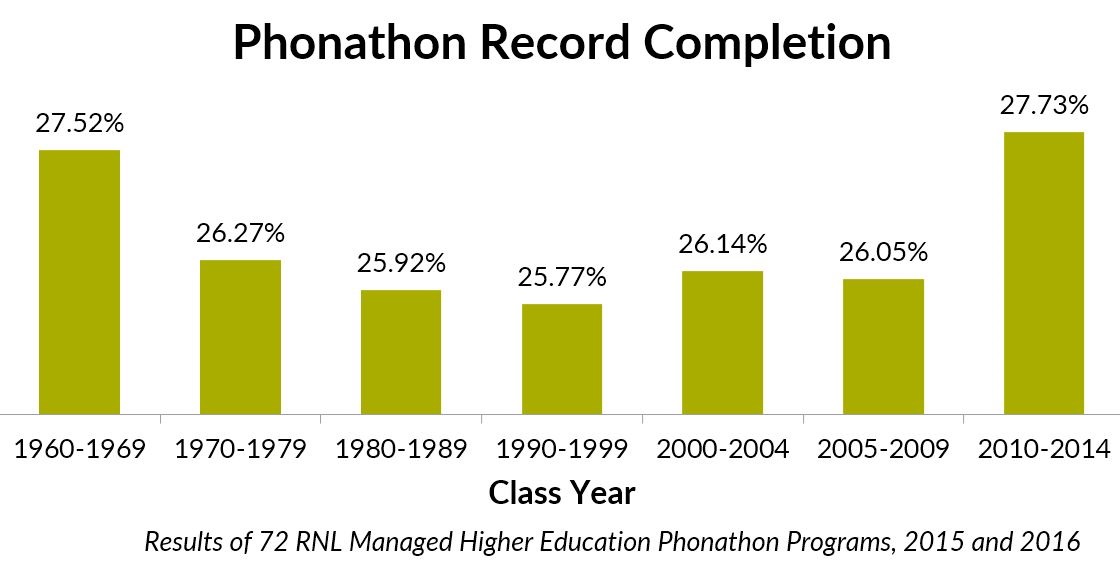
The number of attempts needed to complete a call showed similar results. The youngest group in our analysis needed fewer attempts to complete a call than any group from 1980-2009. Why might this be? When we are calling young people, we’re very likely calling almost entirely mobile numbers, which these prospective donors usually have within reach at all hours of the day.
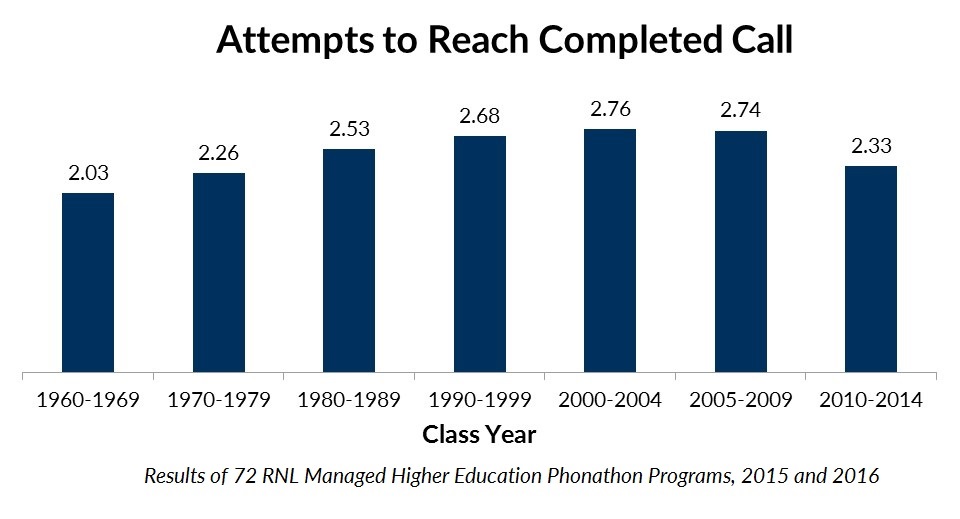
Programs that invest in cell append research to keep calling these numbers do very well with young donors.
Verdict: Myth Busted!
Myth 2: The contact data for young alumni is bad!
We researched this assumption by looking at the contact rate for the 72 programs in our group. Contact rate is the count of actual live conversations (where a solicitation was made) as a percent of completed calls from the last section. And as the chart below shows, the contact rate for recent grads was great, with the rate for Millennial prospects from 2005-09 also very strong. For the group we studied, this is due in large part to our concerted research efforts and our ability to find mobile phone data.
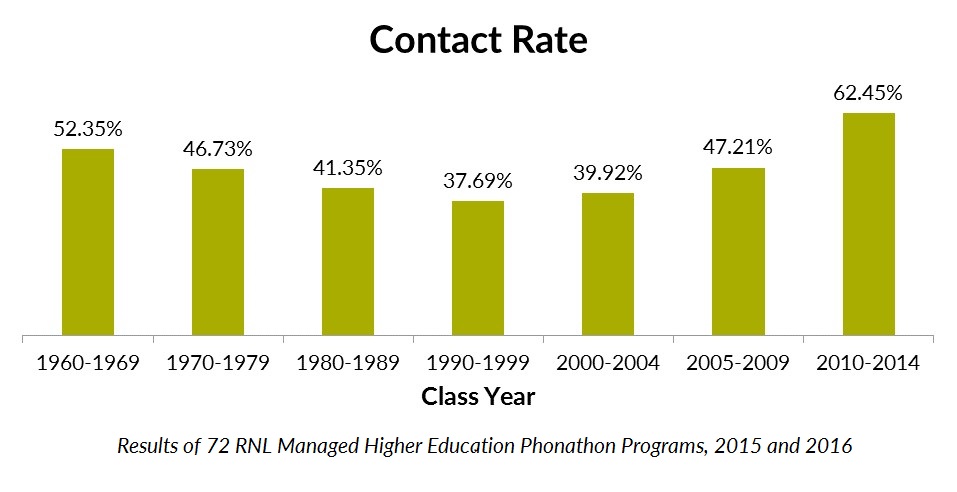
Once again, we see great results from the 2010-2014 grads with a contact rate higher than any other group!
Verdict: Myth Busted!
Myth 3: Millennials don’t give over the phone!
To test this myth, I looked at the specified pledge rate. This is the number of people that made a defined pledge divided by the number of prospects that we actually talked to (contacts). The 2010-2014 group had the second highest pledge rate, losing out to the 2000-2004 graduates by just three tenths of a percentage point.
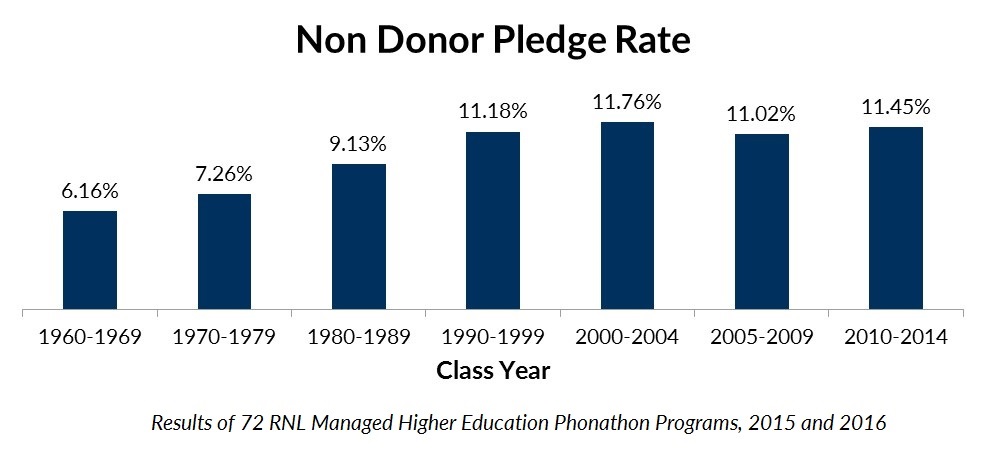
While getting pledges is great, it’s also important to keep track of the people who tell you “please stop calling me.” In every program, we carefully track the number of people who tell us they don’t want to be contacted by phone.
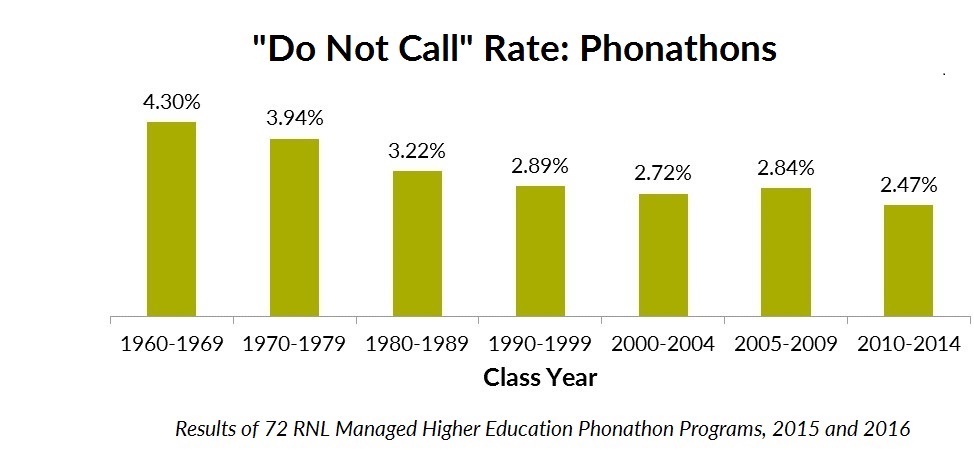
The rate of “do not call” results actually declines as the donors get younger. Recent graduate non-donors seem to react better to phone calls than any other group of graduates.
Verdict: Myth Busted!
What this means: Phonathon remains a strong channel for fundraising with younger donors
Soon, Millennials will be over half of your alumni population, and the phone is a viable channel to solicit these young donors. When used as part of a multichannel strategy along with digital, email, and crowdfunding, we see significant boost in phone results for all generations. Phonathon is clearly alive, and when used tactically as part of a symphony of solicitations, it can be very effective. Especially with Millennials.
To take your phonathon to the next level and engage supporters of all generations, contact RNL today and we’ll give you the best strategy based on our work with hundreds of phone outreach programs and over $1 billion in phone pledges since 2007. Or join us for our year-end webinar, Fundraising Best Practices: 2016 Year in Review.